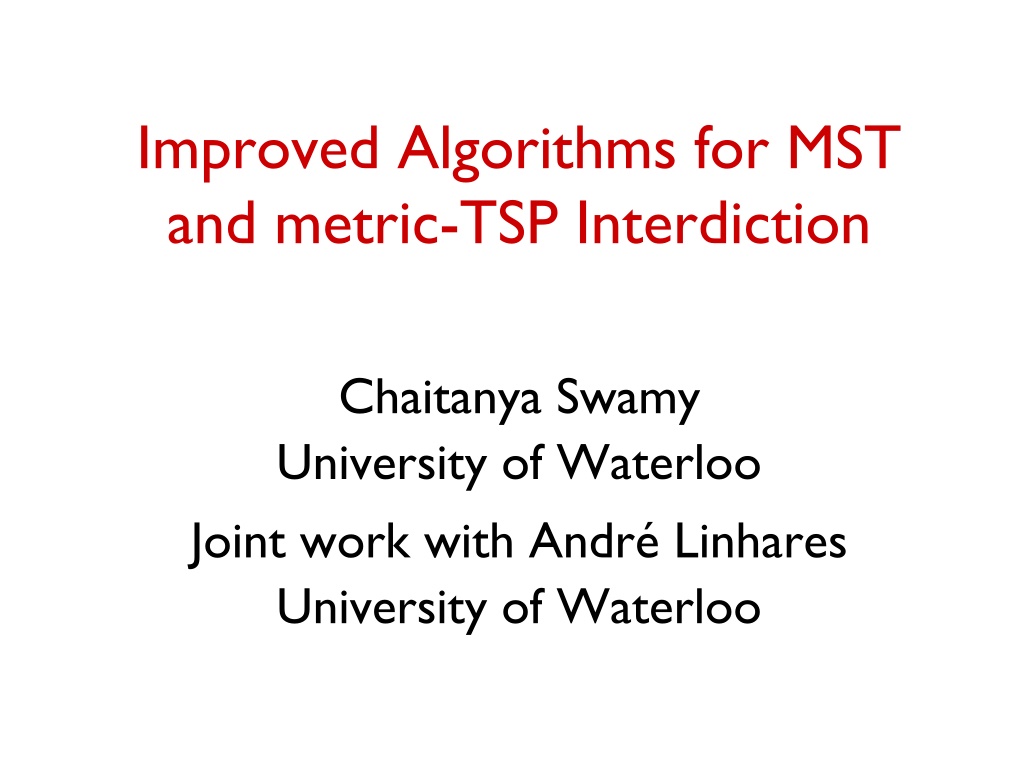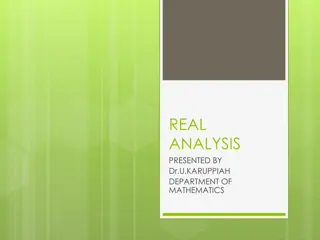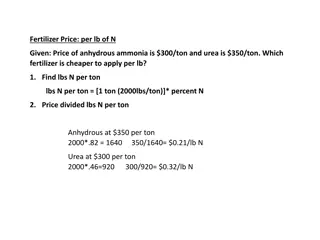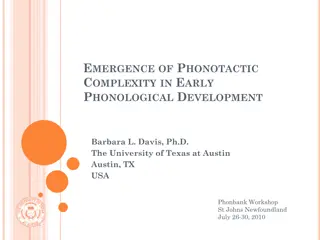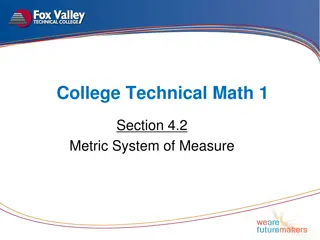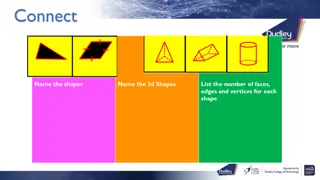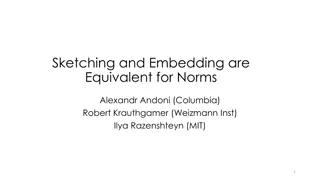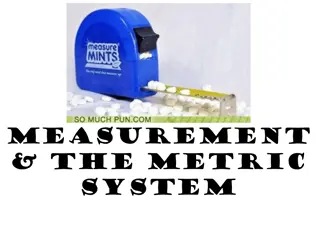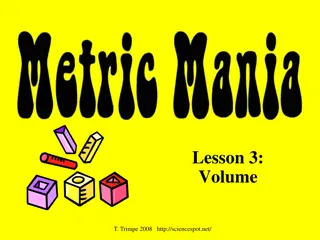Improved Algorithms for MST and Metric-TSP Interdiction
This research discusses improved algorithms for Minimum Spanning Tree (MST) and metric Travelling Salesman Problem (TSP) interdiction to maximize the weight of MST in a graph by removing a specified number of edges. It explores various scenarios, including interdiction costs and budgets, aiming to optimize the weight of MST in the remaining graph.
Download Presentation

Please find below an Image/Link to download the presentation.
The content on the website is provided AS IS for your information and personal use only. It may not be sold, licensed, or shared on other websites without obtaining consent from the author. Download presentation by click this link. If you encounter any issues during the download, it is possible that the publisher has removed the file from their server.
E N D
Presentation Transcript
Improved Algorithms for MST and metric-TSP Interdiction Chaitanya Swamy University of Waterloo Joint work with Andr Linhares University of Waterloo
Minimum spanning tree (MST) interdiction Given: graph G=(V,E), edge weights {we 0}, integer k Goal: interdict (i.e., remove) k edges to Maximize weight of MST in remainder graph 2 5 1 0 0 0 3 0 2 3 3 2 3 1 1
Minimum spanning tree (MST) interdiction Given: graph G=(V,E), edge weights {we 0}, integer k Goal: interdict (i.e., remove) k edges to Maximize weight of MST in remainder graph 2 5 1 0 0 0 3 0 2 3 3 2 3 1 1 MSTw(G) = 6
Minimum spanning tree (MST) interdiction Given: graph G=(V,E), edge weights {we 0}, integer k Goal: interdict (i.e., remove) k edges to Maximize weight of MST in remainder graph 2 5 1 0 0 0 k = 2 3 0 2 3 3 2 3 1 1 MSTw(G) = 6
Minimum spanning tree (MST) interdiction Given: graph G=(V,E), edge weights {we 0}, integer k Goal: interdict (i.e., remove) k edges to Maximize weight of MST in remainder graph weight of MST in G R under {we} weights 2 5 1 0 0 0 k = 2 MSTw(G R) = 9 3 0 2 3 3 2 3 1 1 MSTw(G) = 6
Minimum spanning tree (MST) interdiction Given: graph G=(V,E), edge weights {we 0}, integer k Goal: interdict (i.e., remove) k edges to Maximize weight of MST in remainder graph we 2 5 1 0 0 0 k = 2 MSTw(G R) = 9 More generally, we have interdiction costs {ce 0}, budget B 3 0 2 3 3 2 3 1 1
Minimum spanning tree (MST) interdiction Given: graph G=(V,E), edge weights {we 0}, integer k Goal: interdict (i.e., remove) k edges to Maximize weight of MST in remainder graph we , ce 2, 30 5, 30 1, 20 0, 20 0, 7 0, 13 3, 132, 7 k = 2 MSTw(G R) = 9 More generally, we have interdiction costs {ce 0}, budget B 3, 8 0, 13 2, 13 3, 10 1, 20 3, 20 1, 17 B = 40 Goal: interdict edges of cost B to maximize weight of MST in remainder graph Max R E: c(R) B MSTw(G R)
Minimum spanning tree (MST) interdiction Given: graph G=(V,E), edge weights {we 0}, integer k Goal: interdict (i.e., remove) k edges to Maximize weight of MST in remainder graph we , ce 2, 30 5, 30 1, 20 0, 20 0, 7 0, 13 3, 132, 7 k = 2 MSTw(G R) = 9 More generally, we have interdiction costs {ce 0}, budget B 3, 8 0, 13 2, 13 3, 10 1, 20 3, 20 1, 17 B = 40 MSTw(G R) = 14 Goal: interdict edges of cost B to maximize weight of MST in remainder graph Max R E: c(R) B MSTw(G R)
Interdiction problems: examples and motivation Prominent, classical examples are Matching interdiction: delete edges to minimize (max weight of a matching) Shortest-path interdiction: delete edges to maximize (length of shortest s-t path) Max-flow interdiction: delete edges to minimize (value of maximum s-t flow) And MST interdiction:
Interdiction problems: examples and motivation Prominent, classical examples are Matching interdiction: delete edges to minimize (max weight of a matching) Shortest-path interdiction: delete edges to maximize (length of shortest s-t path) Max-flow interdiction: delete edges to minimize (value of maximum s-t flow) O(1)-approximation [Gupta, Dinitz 13] no O(1)-approximation under UGC [E. Lee 17] densest k-subgraph hard [Guruganesh, Sanita, S 15, Chestnut-Zenklusen 15] And MST interdiction: 14-approximation [Zenklusen 15]
Interdiction problems: examples and motivation (contd.) Interdiction problems study sensitivity of optimization problems under removal of a budgeted set of elements Can be used to identify vulnerable spots for reinforcement (e.g., infrastructure protection; strengthening connectivity in a communication network) OR disruption (models attacker s problem; or disrupting an undesirable process, e.g., infection control)
Our results Main result: give a 4-approximation for MST interdiction (i.e., obtain solution of value OPT/4 in polytime) Improves upon previous best 14-approx. (Zenklusen 15) Simpler and cleaner algorithm and analysis Key insights: Problem of extracting a feasible solution from an over-budget set can be captured cleanly by the tree knapsack problem Replaces a greedy procedure in Z 15, and its intricate analysis Can obtain a strong LP-relative guarantee for tree knapsack translates to improved guarantees for MST interdiction Analysis is nearly tight: show lower bound of 3 on approx. ratio achievable using our upper bound (and the one in Z 15)
Our results (contd.) 4-approximation for MST interdiction also gives 8-approximation for TSP interdiction Improves upon the 28-approximation in Z 15 Maximum-spanning-tree interdiction is densest-k-subgraph hard Maximum-spanning-tree interdiction: minimize (max w-weight of spanning tree of G R) R E: c(R) B
Related work General edge weights and interdiction costs Liri, Chern 93: seem to be the first to consider this generality showed that MST interdiction is NP-hard Frederickson, Solis-Oba 99: give an algorithm for unit interdiction costs that also implies O(log |V|)-approximation in general Zenklusen 15: 14-approx. first (and prior-best) O(1)-approx. {0,1} weights, general interdiction costs: Captures budgeted graph disconnection (remove edges within a given budget to maximize no. of components) Engelberg et al. 07: give 2-approximation General weights, unit interdiction costs: k most vital-edges Frederickson, Solis-Oba 99: O(log k)-approximation
RECALL: MST interdiction Given: graph G=(V,E), edge weights {we 0} interdiction costs {ce 0}, budget B Goal: interdict edges of cost B to maximize w-weight of MST in remainder graph Max R E: c(R) B we , ce (val (R) := MSTw(G R)) 2, 30 5, 30 1, 20 0, 20 0, 7 0, 13 0, 13 3, 132, 7 3, 8 2, 13 3, 10 1, 20 3, 20 1, 17 B = 40
RECALL: MST interdiction Given: graph G=(V,E), edge weights {we 0} interdiction costs {ce 0}, budget B Goal: interdict edges of cost B to maximize w-weight of MST in remainder graph Max R E: c(R) B we , ce (val (R) := MSTw(G R)) 2, 30 5, 30 1, 20 0, 20 0, 7 0, 13 0, 13 3, 132, 7 val(R) = 14 3, 8 2, 13 3, 10 1, 20 3, 20 1, 17 B = 40
Notation and basic facts 0 w1 < w2 < < wk : Ei := {e E: we = wi}, E i := E1 E2 Ei Define w0 := 0, E0 = E 0 := Let OPT := Max (val(R) := MSTw(G R)) R E: c(R) B distinct edge weights for i=1, ,k ?(F) := no. of components of (V, F) Lemma: We may assume: (i) there is a feasible solution of value wk (ii) no edges of Ek are interdicted; OPT : = Max val(R) s.t. R E k-1, c(R) B (iii) (V, Ek) is connected Lemma: For R E k-1, we have val(R) = ??+ ?=0 ? 1?(? ?\?)(??+1 ??)
Lagrangian relaxation OPT : = Max val(R) s.t. c(R) B R E k-1 Lagrangify budget constraint to obtain relaxation: Min ?B + [Max R E k-1 ? 0 val(R) ?c(R)] UB := val(R): supermodular (P?) So (P?) polytime solvable by supermodular maximization Lemma (Zenklusen 15): Can find in polytime, either: an optimal solution to MST interdiction; OR some ? 0, optimal solutions R1 R2 to (P?) with c(R1)<B<c(R2) s.t. a val(R1)+b val(R2) = UB OPT (where a, b 0, a+b = 1, a c(R1) + b c(R2) = B) Main task and chief contribution: show to extract a feasible solution R from R1 and R2 s.t. max{wk, val(R1), val(R)} UB/4
Extracting a good solution from R2: reduction to tree knapsack ? 1?(? ?\?2)(??+1 ??) RECALL val(R2) = ??+ ?=0 Components in ?(? ?\?2) across all i give rise to a tree V= {a,b,c,d,e,f} ? 3\?2 Suppose w1<w2<w3: distinct edge weights (recall w0=0, E 0 = ) ? 2\?2 a,d,e b,c,f f b,c a,d e ? 1\?2 d e f b c a ? 0\?2 Idea: Form solution by selecting suitable subset of components from ?=0 ? 1?(? ?\?2), or equivalently subset of nodes of tree
Reduction to tree knapsack (contd.) ? 1?(? ?\?2)(??+1 ??) RECALL val(R2) = ??+ ?=0 V= {a,b,c,d,e,f} ? 3\?2 Suppose w1<w2<w3: distinct edge weights (recall w0=0, E 0 = ) ? 2\?2 a,d,e b,c,f f a,d b,c e ? 1\?2 d e f b c a ? 0\?2 Idea: Form solution by choosing subset of (non-root) tree nodes Each tree node v in level ? ?\?2 has: set Sv of vertices vertices of corresponding component value ?? := (wi+1 wi) contribution from component to val(.) wt. ?? := c(?(Sv) ? ?\?2) cost of creating component Sv in level
Reduction to tree knapsack (contd.) RECALL val(R2) = ??+ ?=0 ? 1?(? ?\?2)(??+1 ??) E1 E2 V= {a,b,c,d,e,f} ? 3\?2 over-counted ? 2\?2 a,d,e b,c,f f a,d b,c e ? 1\?2 a, d e d e f b c a ? 0\?2 Idea: Form solution by choosing subset of (non-root) tree nodes Each tree node v in level ? ?\?2 has: set Sv of vertices, value ?? := (wi+1 wi), wt. ?? := c(?(Sv) ? ?\?2) Solve: Max ? ??? s.t. ? ??? ? Issue: ? ??? may over-count cost of boundary edges (by a lot) ? ?
Reduction to tree knapsack (contd.) RECALL val(R2) = ??+ ?=0 ? 1?(? ?\?2)(??+1 ??) E1 E2 V= {a,b,c,d,e,f} ? 3\?2 ? 2\?2 a,d,e b,c,f f a,d b,c e ? 1\?2 a, d e d e f b c a ? 0\?2 Idea: Form solution by choosing subset of (non-root) tree nodes Each tree node v in level ? ?\?2 has: set Sv of vertices, value ?? := (wi+1 wi), wt. ?? := c(?(Sv) ? ?\?2) Solve: Max ? ??? s.t. ? ??? ? Issue: ? ??? may under-count cost of boundary edges (by a lot) Fix: Require that if we pick v, we also pick all its descendants c(?(Sv) ??\?2) ? ?
Tree Knapsack problem Given: rooted tree T=({r} N, A), node values {?? 0}, node weights {?? 0}, budget B Goal: Max ?(?) s.t. ? ? is downwards-closed, ? ? ? ? ? all descendants of v are in Q r 3, 5 2, 3 1, 0 2, 5 1, 2 9, 5 3, 5 5, 1 4, 2 4, 1 3, 2 1, 3
Tree Knapsack problem Given: rooted tree T=({r} N, A), node values {?? 0}, node weights {?? 0}, budget B Goal: Max ?(?) s.t. ? ? is downwards-closed, ? ? ? Standard knapsack: special case when T is a star r Introduced by Johnson- Niemi 83 gave FPTAS via dynamic programming 3, 5 2, 3 1, 0 2, 5 1, 2 9, 5 We need guarantees relative to the natural LP: not known previously 3, 5 5, 1 4, 2 4, 1 3, 2 1, 3
Tree Knapsack problem Given: rooted tree T=({r} N, A), node values {?? 0}, node weights {?? 0}, budget B Goal: Max ?(?) s.t. ? ? is downwards-closed, ? ? ? Easy to write down an LP with node variables: (TK-P) Observation: R2 (the over-budget set) gives a feasible solution to (TK-P) of good objective value Theorem: Can compute an integer solution to (TK-P) of objective value OPT(TK-P) maxchains C N ?(?) r 3, 5 2, 3 1, 0 2, 5 1, 2 9, 5 3, 5 5, 1 4, 2 4, 1 3, 2 1, 3
Tree Knapsack problem Given: rooted tree T=({r} N, A), node values {?? 0}, node weights {?? 0}, budget B Goal: Max ?(?) s.t. ? ? is downwards-closed, ? ? ? Easy to write down an LP with node variables: (TK-P) Observation: R2 (the over-budget set) gives a feasible solution to (TK-P) of good objective value Theorem: Can compute an integer solution to (TK-P) of objective value OPT(TK-P) maxchains C N ?(?) Proof idea Show that an extreme point of (TK-P) has special structure: at most one subtree rooted at r has fractional values Exploit using iterative rounding
Tree Knapsack to MST interdiction Given: rooted tree T=({r} N, A), node values {?? 0}, node weights {?? 0}, budget B Goal: Max ?(?) s.t. ? ? is downwards-closed, ? ? ? Easy to write down an LP with node variables: (TK-P) Observation: R2 (the over-budget set) gives a feasible solution to (TK-P) of good objective value Theorem: Can compute an integer solution to (TK-P) of objective value OPT(TK-P) maxchains C N ?(?) Observation + Theorem 7-approx. for MST interdiction Refinements of Theorem + interpolating between R1, R2 4-approximation for MST interdiction
Summary and open questions Devise 4-approximation for MST interdiction Improves upon 14-approximation by Zenklusen 15 Simple, clean algorithm and analysis using tree knapsack Obtain first LP-relative guarantees for tree knapsack Show lower bound of 3 on approx. ratio achievable via upper bound used in analysis Open questions Close the gap [3, 4] in analysis. Better guarantees using LPs? LP-relaxation is not obvious, but can be obtained O(1)-approx. for minimum-spanning-forest interdiction? Minimum-basis interdiction for general matroids is densest-k- subgraph hard. Can similar ideas be applied to other network-design interdiction problems?
